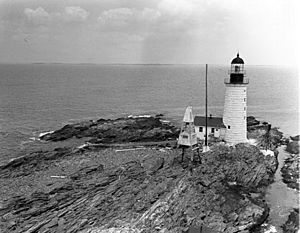Halfway Rock Light facts for kids
 |
|
| Undated US Coast Guard photo | |
|
|
|
| Location | Casco bay off Bailey island |
|---|---|
| Coordinates | 43°39′20.8″N 70°2′12.426″W / 43.655778°N 70.03678500°W |
| Year first constructed | 1871 |
| Year first lit | 1871 |
| Automated | 1975 |
| Foundation | Granite |
| Construction | Granite |
| Tower shape | Conical |
| Markings / pattern | White with black lantern |
| Focal height | |
| Original lens | 3rd order Fresnel lens, 1871 |
| Current lens | VRB-25, 1994 |
| Range | 19 nautical miles (35 km; 22 mi) |
| Characteristic | Fl R 5s |
| Fog signal | HORN: 2 every 30s operates continuously |
Halfway Rock Lighthouse is a cool lighthouse that stands on a lonely rock in Casco Bay, Maine. This rock is called "Halfway Rock" because it's right in the middle of Casco Bay. It's about halfway between Cape Elizabeth and Cape Small.
The lighthouse tower is about 76 feet (23 m) tall. Only the tower and an old boathouse are left today. Strong storms have washed away other buildings over the years.
This historic lighthouse was added to the National Register of Historic Places in 1988. This means it's an important place to protect. In 2014, a person named Ford Reiche bought the lighthouse. He worked to fix it up, and his project was even shown on the TV show Building Off the Grid.
Building the Halfway Rock Light
People first realized a lighthouse was needed on Halfway Rock way back in 1835. A ship called Samuel crashed into the rock during a storm. The rock is only about ten feet above the water on a calm day. This makes it very hard to see when storms hit.
At first, the government didn't do anything. But in 1861, another ship crashed on Halfway Rock. This time, the idea of building a lighthouse was taken more seriously.
Work began on the lighthouse. However, the project faced many delays. There weren't enough supplies or workers. Finally, ten years later, in 1871, the lighthouse was finished. The first light shone from Halfway Rock.
Life at the Lighthouse
When the lighthouse was new, the keepers lived inside the tower. Later, in 1888, a boathouse was built. It had extra living space for the keepers on its top floor.
The original light came from a special lens called a Fresnel lens. It shone a steady white light with a red flash once every minute. In 1887, a fog bell was added to help ships in foggy weather.
As technology improved, the bell was replaced. In 1905, a loud fog "trumpet" was installed instead. Getting to Halfway Rock was always difficult. In the 1930s, the Coast Guard started using a tender boat. This boat would take the keepers to the mainland and back to the rock. There was even a helicopter landing pad for emergencies.
Modern Changes and Restoration
In 1975, the lighthouse became automated. This meant that machines took over the work, and lighthouse keepers were no longer needed. The old Fresnel lens is now in a museum. You can see it at the United States Coast Guard Academy in New London, Connecticut. The light used today is a modern one called a VRB-25.
A big storm in 1991, sometimes called the "Perfect Storm," destroyed the marine railway. This was a track used to pull boats out of the water. Another storm in 2007 badly damaged the wooden building attached to the lighthouse.
The lighthouse was later given to the American Lighthouse Foundation. This group worked hard to raise money to fix it up. In September 2014, Halfway Rock Light was sold at an auction for $283,000. Its restoration was featured on the TV show Building Off the Grid in 2017.


